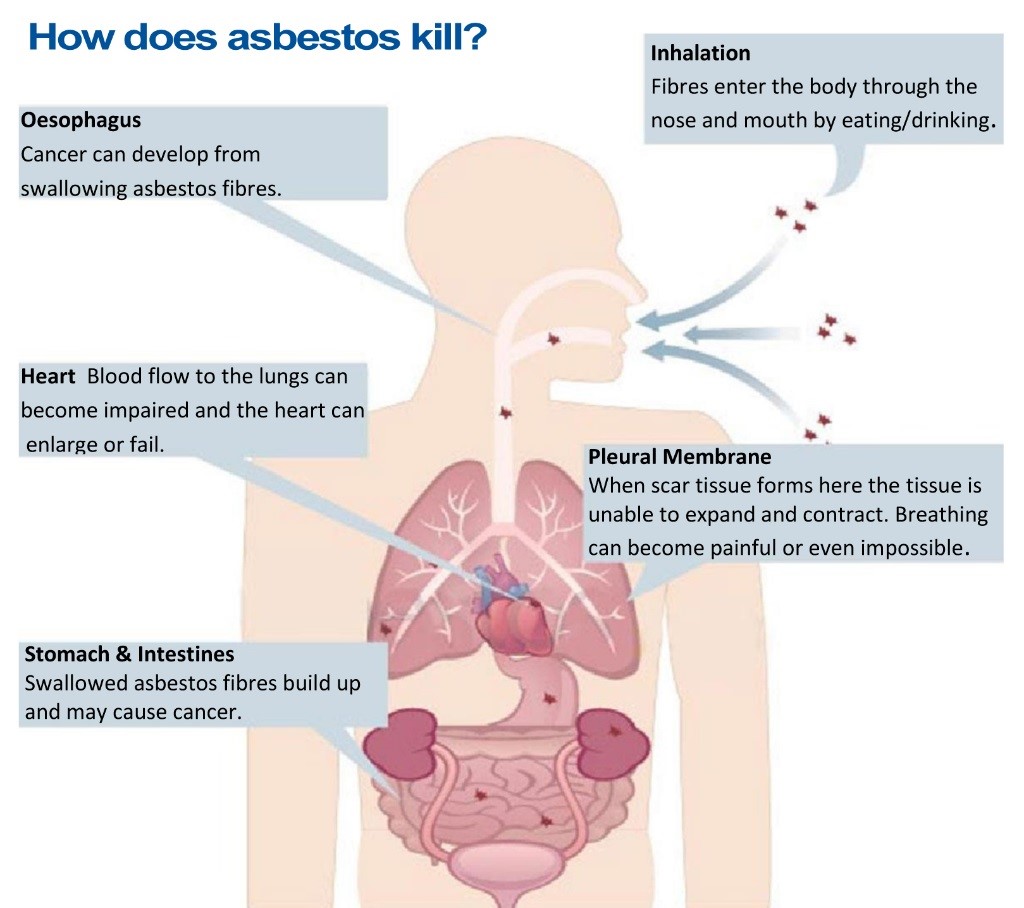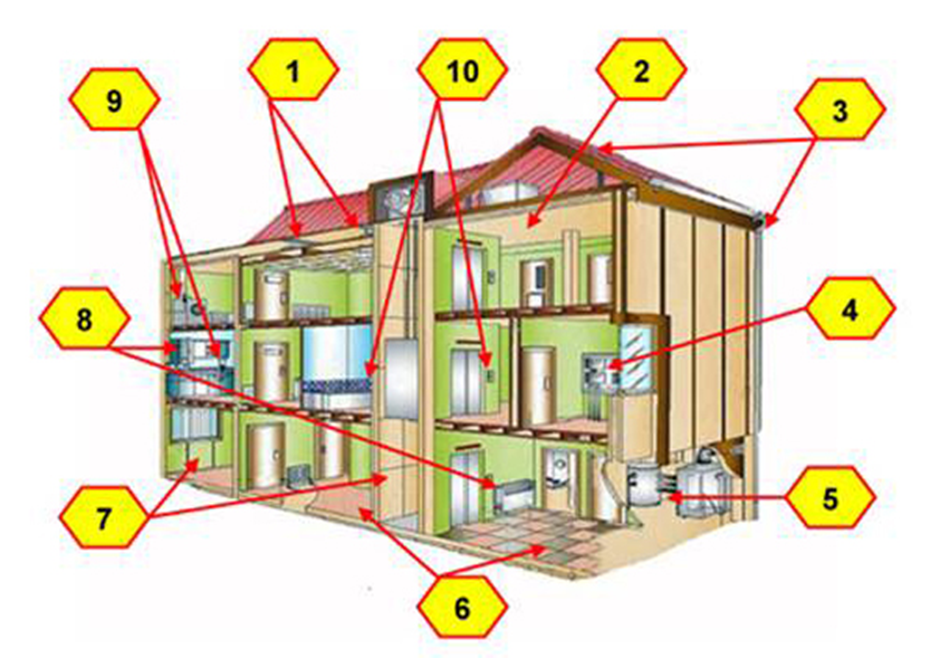Asbestos is a building material made from fibrous silicate minerals, used by manufacturers and builders in the late 19th century for its qualities in insulation, heat resistance and sound absorption. We take a look at the different types of asbestos, and the dangers of asbestos in the home.
Types of Asbestos
There are three main types:
- Blue (Crocidolite) varies in colour from a dull slate grey to a vibrant dark blue, and is best known for having a stronger heat resistance than other types of asbestos. Mostly mined in Bolivia, South Africa and Western Australia; Crocidolite is seen as the most dangerous type of asbestos, due to the fibres being so thin.
- Brown (Amosite) referred to as brown asbestos, because of its colour, which is produced by the iron and magnesium qualities found. Amosite consists of long, thin, brittle fibres in which break off very easily, proving to be a dangerous substance when disturbed due to its ability to become inhaled easily.
- White (Chrysotile) is the most commonly used type of asbestos, and can still be found today in a variety of materials including roofs, walls and ceilings, to name a few. Chrysotile asbestos was primarily used for thousands of commercial products, including household appliances, floor coverings and insulating materials.
Identifying Asbestos
Asbestos can be identified only by those who know what they are looking for, due to the fibres being smaller than a human hair and very difficult to spot with the human eye, making it a hidden killer. Any items found to contain asbestos should be labelled with a correct warning notice. In many instances, suspected substances will have to be sent to a laboratory for analysis.
Asbestos in the Home
- Sprayed coating
- Textured coating, e.g. artex
- Asbestos cement sheets and moulded products
- Electrical fuse boards and panels
- Insulations and lagging to plant and pipe work
- Floor coverings and floor tiles
- Asbestos insulating board and wall (AIB)
- Gas and electrical heater
- Textiles and Gaskets
- Other materials
Asbestos can be found in many different materials encompassing the home. The diagram above illustrates the various uses asbestos has; from insulations and lagging, to plant and pipe work, textured coating and electrical fuse boards and panels. Generally, these types of ACM’s are located throughout the perimeter of the household, each providing a level of insulation, sound absorption and heat resistance.
Dangers of Asbestos
Previous investigations into the use of asbestos revealed it’s toxicity to be a highly dangerous substance. This is because when asbestos-filled items are disturbed, fibres are released into the air. This causes health hazards, as the fibres are inhaled and can become lodged and scar the lungs. Other serious long term health hazards can include lung cancer and mesothelioma (cancer of the abdomen and the chest), although reports suggest that symptoms may not materialise until at least 5 years after the initial exposure to the asbestos fibres. It is especially dangerous to young people, with smokers additionally more likely to suffer a higher health risk.
Who is most at risk?
Any exposure to asbestos can be extremely dangerous, approximately 4000 individuals die in the UK each year from asbestos related illnesses. Those believed to be most at risk however, include: electricians, glaziers, plumbers, gas engineers, maintenance workers, joiners, computer engineers and cleaners.
How does asbestos cause health risks?
From this, it can be seen that by swallowing these toxic fibres, cancer can develop, with asbestos fibres building in the stomach and intestines as a result. Scar tissue can form in the pleural membrane, causing the tissue to lose the ability of expanding and contracting. As a result, breathing can become painful or even impossible. Heart problems can also occur, as the blood flow to the lungs can become seriously impaired, in turn risking the heart to enlarge or fail.
Decline of Asbestos Use
After considering the vast amount of materials that contain asbestos and the poisonous health hazards from this, legislators recognised that it was necessary to take action in order to control and attempt to ban the use of asbestos as a toxic material in the 1970’s. Prohibition laws were introduced in the UK in the mid-1980’s, banning the use of amosite and crocidolite (brown and blue) asbestos, with chrysotile (white asbestos) eventually becoming banned in 1999. Despite the use of asbestos reaching decline significantly worldwide, although there are still many ACM’s manufactured, imported, distributed and widely used in the United States.
Testing for Asbestos

Asbestos should only be tested if work is going to be carried out on the property, if no existing work is planned and there is no damage. Asbestos Containing Materials should be left alone. If work is going to be carried out, expert help is required and safety precautions should be followed correctly. A key component to consider is that testing should never be carried out yourself; the correct training and equipment is required to complete appropriate testing successfully.
Asbestos Removal
Asbestos is safe unless it is disturbed and dust particles get into the air. Although, as work on asbestos is no longer carried out in the UK, the only form of asbestos work that is now undertaken is asbestos removal. However, this can only be completed by a licensed asbestos professional. If ACM’s are intact and in a good condition, without damage and unlikely to be disturbed, they are best left untouched; disturbing ACM’s in any way is not advised.
Asbestos should never be:
- Damaged
- Broken
- Hammered
- Disturbed
- Sawed
- Cut
- Drilled
What can I do if I suspect asbestos may be present?
If you suspect that there may be asbestos materials present in your home and they are damaged or broken, it is strongly advised that you seek a professional asbestos removal engineer. You should not under any circumstances inadvertently disturb asbestos, as the results could be fatal. Maximum exposure limits to asbestos have been set by Asbestos-at-work regulations, with the requirement that all materials should be identified and managed correctly.
What can I expect from a trained engineer?
Only a trained engineer can carry out the removal of asbestos materials, as it is only identifiable by those who know exactly what they are looking for. If there is a health and safety representative they should first be consulted, with prior arrangements made for the safe disposal of these materials. After determining if the ACM’s are in fact present, a trained non-licensed engineer can carry out the following work:
- Replace light fittings attached to AIB
- Replace asbestos containing floor tiles
- Drill holes in asbestos insulating board (AIB)
Any work beyond this requires specialist help due to the threats the toxic material holds.
Summary of Asbestos
- It is highly dangerous and should not be worked on.
- There are three different forms of with variable levels of uses and risks.
- If inhaled, it can cause mesothelioma, an asbestos related disease (as well as other serious health hazards).
- All types of asbestos should only be removed by a trained, fully licensed asbestos engineer.
- It can be found in any building built before 1999.
- It is not a contagious disease and can be perfectly safe unless it is disturbed.
If you are concerned about the dangers of asbestos and believe you are suffering from an asbestos related problem, always be sure to consult a fully qualified professional.





